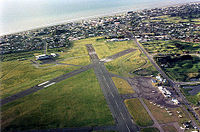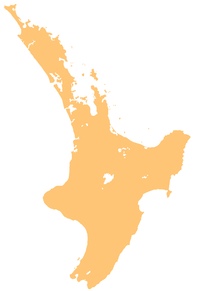- Kapiti Coast Airport
-
- "PPQ" redirects here. See also: Parts-per notation
Kapiti Coast Airport 
Aerial view of Kapiti Coast Airport looking towards Paraparaumu Beach IATA: PPQ – ICAO: NZPP Location of airport in North Island Summary Airport type Unattended, Non-Certificated Aerodrome Location Paraparaumu, Greater Wellington region Elevation AMSL 22 ft / 7 m Coordinates 40°54′20″S 174°59′20″E / 40.90556°S 174.98889°ECoordinates: 40°54′20″S 174°59′20″E / 40.90556°S 174.98889°E Runways Direction Length Surface ft m 16/34 4,429 1,350 Bitumen 16/34 2,001 610 Grass 11/29 3,268 996 Bitumen 11/29 1,345 410 Grass Kapiti Coast Airport (IATA: PPQ, ICAO: NZPP), earlier called Paraparaumu Airport, is on the Kapiti Coast of New Zealand's North Island, between the Wellington dormitory suburbs of Paraparaumu Beach (to the west and north), Paraparaumu to the east, and Raumati Beach to the south. The Wharemauku Stream flows through part of the airport's land.
Originally government-owned, the Kapiti Coast Airport was the greater Wellington region's main airport until Wellington International Airport opened in 1959. It was privatised in 1995.
Contents
History
Constructed by the Royal New Zealand Air Force in July 1939 using equipment from Whenuapai,[1] Paraparaumu was made available as an "Emergency Airport" by the government. The then-grass Rongotai Airport in Wellington was closed for safety reasons on 27 September 1947 until 1959,[2] as the surface often became unusable during winter months. National Airways Corporation was forced to move to Paraparaumu Airport, 35 miles from Wellington, causing a one-third drop in Cook Strait passengers for NAC in a single year, due to the isolation. Nonetheless, Paraparaumu was the country's busiest airport in 1949, with up to 20 DC-3s and Lodestars lined up on its apron.
The original runway dimensions were (16/34) 1350 m x 45 m with a 85 m starter extension available on runway 16, nearly touching Kapiti Road, which runs past the aerodrome. At that time, the secondary runway (11/29) was 1239 m x 30 m.
Paraparaumu was judged unsuitable for international operations in the 1950s due to Kapiti Island to the near west and the Tararua Ranges barely a mile east infringing the take-off and landing flightpaths. Housing areas were very close to the south and west of the airport, and since the mid 1980s to the north as well, directly across Kapiti Road.
New Zealand's Civil Aviation Authority has recently approved the airport after identifying approach obstruction issues. In the intervening years, aircraft performance and improvements in aircraft navigation systems render earlier concerns less critical.
From 1952 to 1957, Wellington unusually had two domestic airports: NAC running Herons from Rongotai (which CAA had agreed to reopen on strict conditions), mainly to Blenheim and Nelson, and to Rotorua via Napier; everything else from Paraparaumu. When NAC introduced Viscounts in early 1958 they could operate to Christchurch and Auckland only, Paraparaumu's runway being about 300 m too short. The reconstructed and much improved Rongotai Airport opened in 1959, although its terminal remained the old Tiger Moth factory until the late 1990s, and Paraparaumu ceased being Wellington's airport and became the a general aviation airfield.
The Kapiti Aero Club is based at the airport, along with other private fliers and charter businesses. The airport is a base for the New Zealand helicopter company Helipro, which offers both fixed-wing and helicopter flight training, charters, and other commercial services. Due to the relative infrequency of commercial flights, it is a popular base for private and leisure flights.
As recently as 1992, alternate sites for a new airport for Wellington were investigated, including Paraparaumu, but a decision was made to upgrade Wellington Airport's existing site.
Interest in providing commercial flights at Paraparaumu reignited[when?][citation needed] because the Kapiti coast is one of New Zealand's fastest growing regional centres. Many of Wellington's more affluent professionals and business people live at Paraparaumu and tolerate the hour-long commute for the lifestyle offered.
In early 2007, the airport was sold by its first private owners to property developer Noel Robinson for NZ$40 million. Since then some of the airport's property has been sold to allow for residential development and part of the secondary runway 11/29 has been closed.
Re-development proposals involve closing 11/29, with a parallel grass runway as the only crosswind runway. A new multi-user terminal is intended for the southern area, now home to gliding activities.
This re-development was spurred by interest from Air New Zealand to operate Q300 aircraft. Planning hearings for airport redevelopment occurred in November 2007, redevelopment completed in 2011 with the refurbishing of the runway and recommissioning of the control tower. The rising costs of Wellington Airport also contributed to Air New Zealand's initiative to schedule flights to Paraparaumu.
On 26 January 2011, Air Nelson, a subsidiary of Air New Zealand, announced that flights would commence between Auckland and Paraparaumu from October 24, 2011.[3][4] The initial flights consist of 3 return flights during weekdays, and 3 flights over the weekend. They are operated with a Bombardier Q300 50 seat aircraft.
Incidents
In 1949 when a Lodestar from Whenuapai (Auckland) crashed into the Tararua Range. Paraparaumu Tower had cleared the aeroplane to fly under Visual Flight Rules when the cloud base was below 800 m and did not ascertain that the aeroplane turned east into the ranges instead of out to sea near Kapiti Island to line up with the main runway.[citation needed]
In 1952 a DC-3 experienced engine failure when about to land on Runway 34, and ploughed into a house in Kohutuhutu Rd, Raumati Beach. Three children on board died in the fire that followed (there were no flight attendants on domestic flights until 1956), but the captain helped everyone else to safety.[citation needed]
On 6 November 1970, Douglas C-47B ZK-AXS of the Ministry of Transport was damaged beyond economic repair during a simulated downwind takeoff,[5] when the undercarriage collapsed.[6] The aircraft was operating a training flight.[5] The fuselage was subsequently used for fire training purposes, and was last reported to be at Wellington.[6]
On 17 February 2008, above an adjacent hardware store, Placemakers, there was a triple-fatality mid-air collision between a Cessna 152 and a helicopter, both of which plummeted from approximately 1500 ft, the helicopter into the store and the plane into a nearby street. No one on the ground was injured.[7]
Airlines and destinations
Airlines Destinations Air2there Blenheim, Nelson, Wellington Air New Zealand operated by Air Nelson Auckland Notes
- ^ [1]
- ^ [2] 11 September 1947 Flight Magazine
- ^ "Air NZ flights start 24 October From Paraparaumu to Auckland". 2011-01-26. http://www.scoop.co.nz/stories/AK1101/S00645/air-nz-flights-start-24-october-from-paraparaumu-to-auckland.htm.
- ^ "Air Nelson to fly from Paraparaumu to Auckland – 3 times a day starting October". 2011-01-27. http://wellington.scoop.co.nz/?p=31258.
- ^ a b "ZK-AXS Accident description". Aviation Safety Network. http://aviation-safety.net/database/record.php?id=19701106-1. Retrieved 20 October 2010.
- ^ a b "Douglas DC-3/C-47 Dakota". Kiwi Aircraft images. http://www.kiwiaircraftimages.com/dakota.html. Retrieved 13 November 2010.
- ^ "Third man dead following mid-air crash". Television New Zealand. 2008-02-17. http://tvnz.co.nz/view/page/1316907/1585872.
External links
- Kapiti Coast Airport website
- Air2there website
- Kapiti Aero Club website
- Helipro website
- New Zealand AIP - Aerodrome & Operational Data
Categories:- Airports in New Zealand
- Wellington Region
Wikimedia Foundation. 2010.

